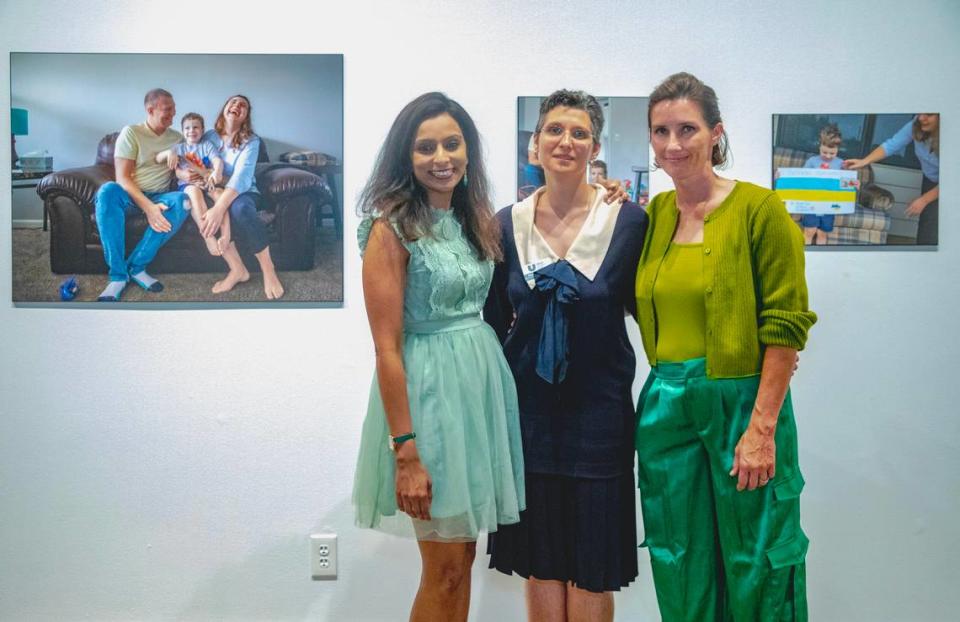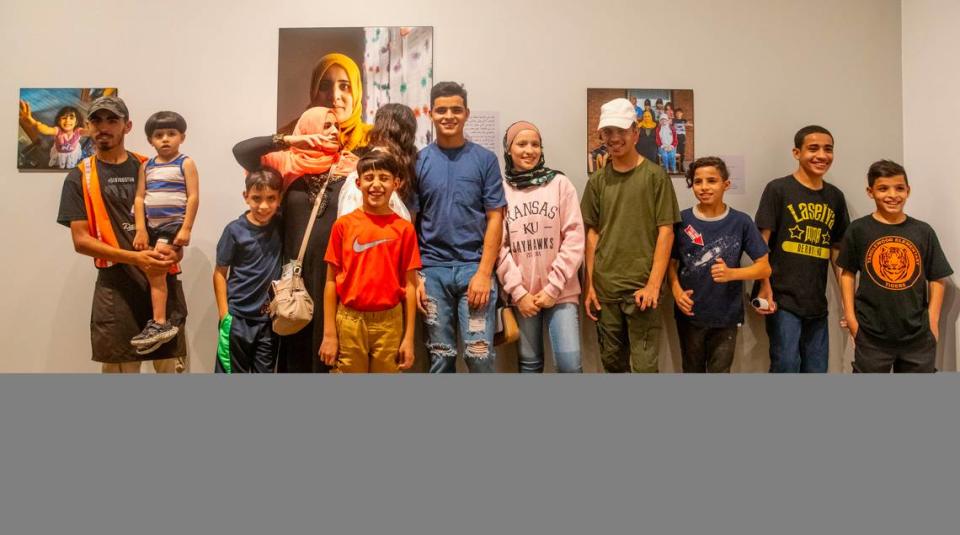Refugees in Wichita share their stories through new exhibition at Ulrich Museum
Bringing a new exhibition to the Ulrich Museum of Art that focuses on what it’s like to be a refugee or asylum-seeker living in Wichita resonated in a personal way for Ksenya Gurshtein and Mythili Menon.
As immigrants, they understand the challenges of moving to a new country. But unlike refugees, they chose to come to Wichita. They both now work at Wichita State, where Menon has been an associate professor of linguistics since 2016 and Gurshtein is the Ulrich’s curator.
The five refugee families featured in the exhibition Menon and Gurshtein put together didn’t have a choice.
They were displaced and unable to live in their home countries of the Democratic Republic of the Congo, Ukraine, Venezuela, Syria and Afghanistan because of war, violence or persecution.
The families all now live in Wichita, and their stories of the lives they left and what they’ve found in Wichita are part of the exhibition “Where We Belong: Refugee Stories from Wichita,” which is on display now through Dec. 7 at the Ulrich Museum on the Wichita State University campus.

The stories are told through portraits and casual photographs of the families, taken by WSU photography instructor Kendra Cremin, with image labels culled from hour-long interviews conducted with each family by Menon and Gurshtein. The families told their stories in their native languages using interpreters. The text on the image labels is presented in the family’s native language with an English translation.
Being represented
As a linguist, Menon felt it was important that the interviews with the featured families be conducted in their native languages.
The exhibition also includes a video, compiled from footage shot by Cremin during the interviews. An exhibition brochure provides some historical context about the conflicts in each of the family’s home countries as well as information about the challenges of being a refugee.
“We wanted to have representation in terms of different countries from across the globe,” said Menon, who worked with caseworkers from the local International Rescue Committee chapter to help identify families willing to participate.
Menon has been working with the IRC on other projects through the Center for Educational Technologies to Assist Refugee Learners, which she started and directs at WSU. Using interdisciplinary expertise from various WSU departments, the center has created a digital game-based bilingual learning platform that helps school-age children learn both English and science. Menon said that more than 90 non-English languages are spoken within the Wichita public school district. The exhibition includes a station where visitors can try out the game.
Part of the Ulrich Museum’s mission is to tell stories from different perspectives and reach new audiences. For several years, it has also had exhibitions highlighting research happening at WSU. This exhibit allows it to do both, Gurshtein said.

Photography has been a compelling medium used to bring attention to various social injustices. One of the best examples is the work of Gordon Parks, whose photographs chronicled poverty, race relations and more.
This exhibition takes a similar approach.
Zahra, a single mother from Syria with 11 children ages 4 to 18, came to Wichita after spending years in a refugee camp in Lebanon. Her husband died because of the fighting in Syria. One human rights group reports as many as a half-million people have died because of the country’s civil war that rose out of the Arab Spring uprising in 2011.
“I haven’t seen my brother in 13 years,” she said during the interview for the exhibition project. “I haven’t heard anything from my sister or parents in five years because of the war. … I would not wish what happened to Syria on any other country.”
Photographed in a gold-colored head cover, Zahra said she initially worried about being discriminated against in America because she is a Muslim. That hasn’t been the case, said Zahra, who walks more than two miles to get to her job at a popular Middle Eastern restaurant in Wichita.
An image of her daughter, smiling with outstretched open arms, is accompanied by Zahra’s sentiments about what living in America means to her and her family: “The children can have childhoods here ….”
Wissa Malikazia and his family also escaped political upheaval. Originally from Jalalabad, the family was among the emergency evacuees who left Afghanistan when the Taliban took over in August 2021. The family, which includes four sons, now ages 16 through 27, came to Wichita two years ago by way of Qatar, Germany and Virginia.
“It’s a really big difference between here and there, it’s like earth and sky because we came from a war-torn country,” reads the label next to the photographs depicting the Malikazia family. The family left everything — including their dog, the father’s job as an irrigation engineer, the mother’s job as a teacher and one son’s scholarship to become a dentist — behind to hastily come to the United States. One of the sons is now enrolled at Wichita State University.
Nataliia Trafimovych, her husband, Artem, and young son, Zakhar, were vacationing in Egypt when Russian troops invaded their home country of Ukraine. They spent time as refugees in Poland before coming to Wichita six months ago as part of the United States’ special Uniting for Ukraine program that allows U.S. citizens to be sponsors for Ukrainian refugees.
The text labels accompanying the images of the Venezuelan family, comprising a mother and her four children ages 5-22, share tiny snippets of what was a months-long journey, much of it on foot, to come to the United States to request asylum through a special humanitarian program.
The largest group of refugees in Wichita are those from the Democratic Republic of the Congo. The experience of one family, comprising a father, mother and seven children, is also shared in the exhibition. Members of the family have fun showing off dance moves in the exhibition video.
Several free, public programs are scheduled to accompany the exhibition, including a Sept. 21 event where Menon will talk about the research done at her center. The work being done by the IRC will be the featured topic at an Oct. 24 program. Both events start at 5:30 p.m. and are at the Ulrich. The final program will be the film screening of “Midnight Traveler” at 2 p.m. Dec. 2 in the CAC Theater on the WSU campus.
A complete list of events and more information about the exhibition, including its brochure and video, can be found online at ulrich.wichita.edu/ulrich_exhibition/where-we-belong-refugee-stories-from-wichita
‘Where We Belong: Refugee Stories from Wichita’
What: A multimedia exhibition featuring the stories and photos of five refugee and asylee families
Where: Ulrich Museum of Art, on the campus of Wichita State, 1845 Fairmount
When: Through Dec. 7; hours are 11 a.m.-5 p.m. Mondays through Saturdays; closed Sundays and major holidays
Admission: Free
More information: ulrich.wichita.edu

